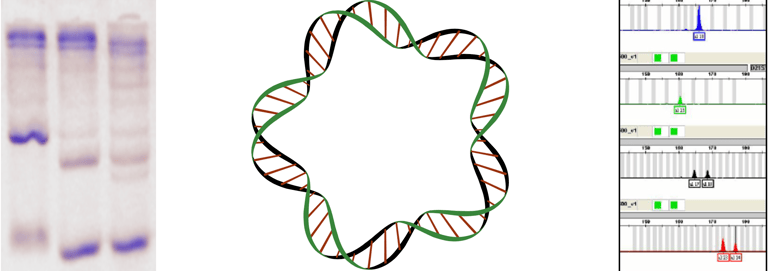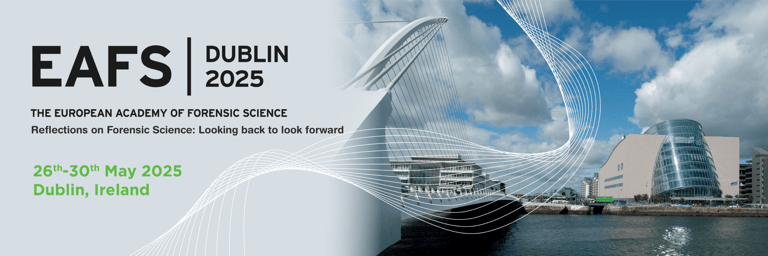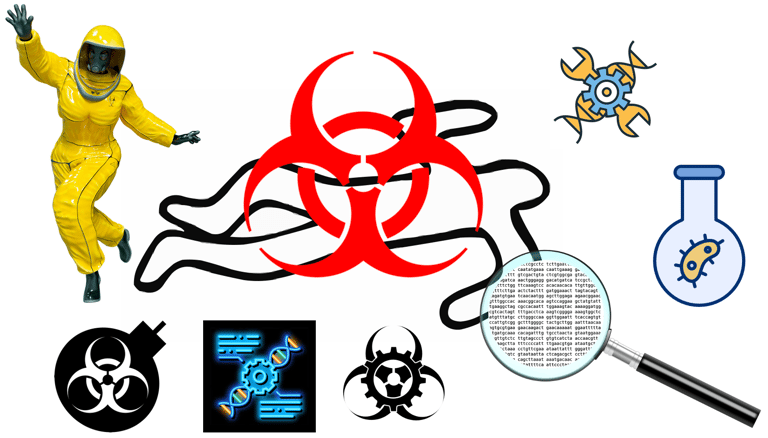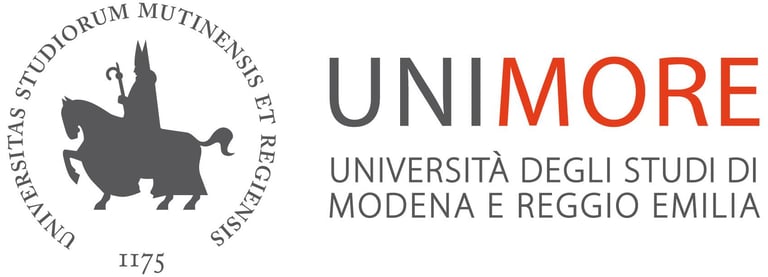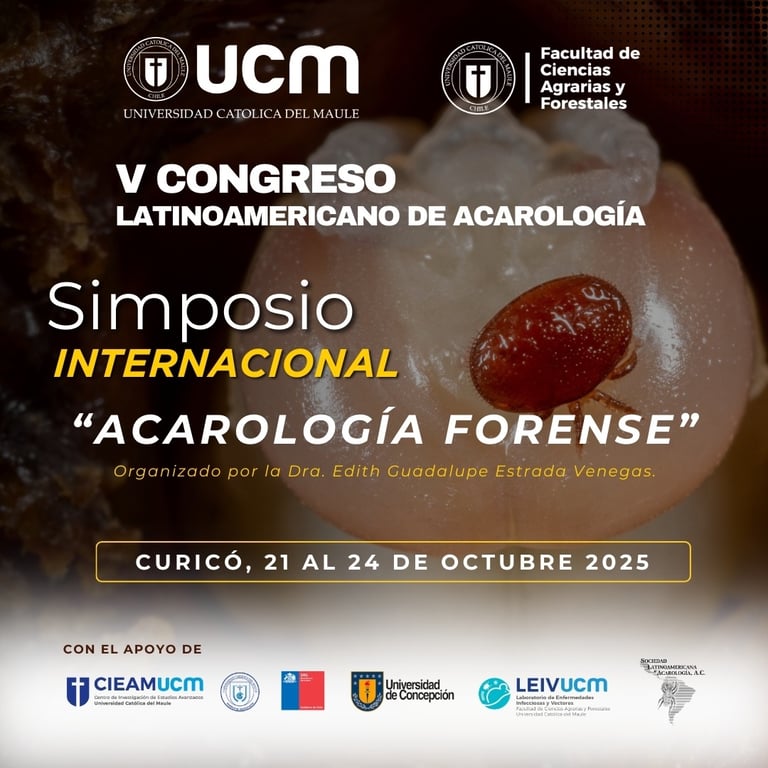Upcoming Events, Conferences, and Workshops in Forensics
28 April - 2 May 2025
Prague, Czech Republic
Introduction to Developing Genetic Markers for Animal and Plant Traces
Molecular Resources in Non-Human Forensics: from Wildlife to eDNA
26-30 May 2025
Dublin, Ireland
EAFS 2025
European Academy of Forensic Science (EAFS)
Reflections of Forensic Science: Looking back to look forward
click on image
Workshops
Conferences
3 - 6 June 2025
Genoa, Italy
Introduction to Forensic Microbiology and Mycology
On the Utility of Cadaveric Fungi in Crime Investigations
3 - 19 June 2025
Modena, Italy
Introduction to Forensic Palynology
On the Forensic Utility of Pollen, including Identification of Pollen using the Reference Collection for Central Europe and the Mediterranean
August 2025
Lisbon, Portugal
Crime Scene Protocol, Case Work, and Reporting
Studies of the entomofauna of carcasses and corpses in arid environments of Argentina applied to the estimation of the post-mortem interval
F.H. Aballay 1, F.N. Jofré 2, A.R. Cortez Vega 1, M. Moghadaszadeh Kermani 3, M.A. Perotti 3
1 National University of San Juan, Institute and Museum of Natural Sciences, San Juan, Argentina,
2 Argentine Institute for Research on Arid Zones (IADIZA, CCT-CONICET Mendoza), Entomology Laboratorium, Mendoza, Argentina,
3 University of Reading, School of Biological Sciences, Reading, United Kingdom
Cadaveric decomposition experiments and sampling with baited traps in different arid environments provide information that allows answers to forensic questions of post-mortem interval (PMI) and location or relocation of corpses. Entomofauna from pig carcasses was sampled daily during the entire process of decomposition, from experiments in Mendoza and in San Juan, Argentina.
Human corpses were sampled at the discovery sites as well as in the judicial morgues, following authorization by the directors of the Public Prosecutor's Office of San Juan and Mendoza. The study of environmental variables was carried out at the discovery sites and at the meteorological stations closest to the site where the bodies were found.
Case 1: the corpse was found in an urban-rural environment in summer, recording Chrysomya albiceps, Cochliomyia macellaria (Calliphoridae), Piophila casei (Piophilidae) (Diptera); Dermestes maculatus(Dermestidae) (Coleoptera) etc., the estimated PMI is 12 days.
Case 2: the body was found in summer in a natural mountain environment, recording D. maculatus, Omopheres sp (Tenebrionidae), Necrobia rufipes (Cleridae) (Coleoptera) and Piophila casei (Piophilidae), the estimated PMI is 21 days and the entomofauna suggest relocation of the body
Case 3: bone remains were found in a dry river in a rural environment in summer, recording Anthrenus verbasci (Dermestidae), Acromyrmex sp. (Formicidae) (Hymenoptera) and Uroobovella mites (Urodinychidae, Mesostigmata, Acari); and the entomofauna suggest relocation of the body as well.
The composition and abundance of cadaveric entomofauna changes in different environments and seasons of the year.
Forensic eDNAir – environmental DNA in the air – in Argentina
L.M. Díaz Nieto 1, Mahdieh Emadi 1, M. Moghadaszadeh Kermani 2, H.R. Braig 1
1 National University of San Juan, Institute and Museum of Natural Sciences, San Juan, Argentina,
2 University of Reading, School of Biological Sciences, Reading, United Kingdom
Currently, research and case work (collection and analysis) on trace DNA are developing independently of each other for human trace DNA and non-human trace DNA. This is not sustainable in the future. Classically, human traces are mainly dispersed through blood, saliva, sweat, vomit, sperm, bodily fluids, ... . These are obvious trace samples. But there are also latent, hidden trace samples. Human touch DNA is latent trace sample. Touch DNA is a form of human environmental DNA (eDNA). DNA contains human DNA, animal DNA, plant DNA, microbial DNA, everything. eDNA is not limited to surfaces or water. eDNA is also in the air, and most of what settles in dust originates from the air.
In San Juan, Argentina, as part of the Horizon Europe Marie Skłodowska-Curie Actions Doctoral Network Natural Traces in forensic investigations - how the analysis of non- human evidence can solve crime, we try to combine the collection and analysis of human and non-human eDNA.
Air Forensics faces various challenges. Most often, there is more than one person present. How far is individualization possible in mixed air samples? How can non-human DNA be linked to humans and the sampled environment? How can long-distance transport of airborne DNA be recognized in samples? Is the forensic application limited to indoor crime scenes? Outdoor macrobial airborne DNA is increasingly important in ecology.
Will in the future the first forensic sample being taken at a crime scene be air?
21-24 October 2025
Curicó, Chile
Second International Symposium on Forensic Acarology
during the 5th Latin American Congress of Acarology
click on image
Forensic acarology is a new area within acarology, dedicated to the study of mites associated with cadaveric decomposition. This area has only been studied in a few countries: the United Kingdom, the United States, Mexico, Argentina, Chile, among others. This important area has proven to be an effective tool in forensic systems in some countries. Mites provide evidence in postmortem periods, primarily regarding the movement of the body from the location of the body, the condition of death, and the condition of the victim.
Because of this, it was decided to promote the knowledge generated by bringing together experts from different countries. At the IV CLAC (Spanish National Council of Forensic Acarology) held in Panama in 2023, the "First International Symposium on Forensic Acarology" was held, bringing together eight researchers from the United Kingdom, Spain, Argentina, and Mexico. The conference generated great interest, generating a large number of questions among attendees, as well as interest in launching the field in countries like Brazil.
Therefore, at this 5th CLAC, it was decided to organize the second symposium, where current information from different countries will be presented. Speakers from the United Kingdom, Spain, Mexico, and Brazil have already been secured.
Dr. Edith Guadalupe Estrada Venegas, Organizer of the Second International Symposium on Forensic Acarology
Mexican acarologist, working in areas such as Agricultural and quarantined acarology, important soil mites, Forestry acarology, and Forensic acarology. She has trained national and international undergraduate, master's, and doctoral students. She has conducted research projects with various countries and institutions. She is a member of the Mexican National System of Researchers. She is a founding member of the Latin American Society of Acarology. She is also the former president of the Mexican Society of Entomology. She has 85 publications in national and international journals, 30 book chapters, and has edited several books.
Developing the field of Forensic Acarology in various aspects, generating relevant information for Mexico. Participating in national and international conferences such as ICA, SIBAC, CLAC, and EURAC, among others. Promoting Acarology in all its areas in Latin America through virtual and in-person courses and talks, as well as human resource training.
